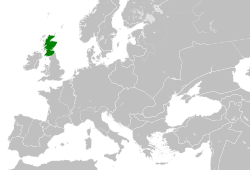Kingdom of the Scots
| Kingdom of Scotland | ||||||||||||||||||||||||
|
||||||||||||||||||||||||
|
||||||||||||||||||||||||
|
||||||||||||||||||||||||
Motto
|
||||||||||||||||||||||||
|
Location of Scotland in 1190 CE. (green)
in Europe (green & grey) |
||||||||||||||||||||||||
| Capital | Edinburgh (after c. 1452) | |||||||||||||||||||||||
| Languages |
|
|||||||||||||||||||||||
| Religion | Catholicism, Episcopalianism, Presbyterianism | |||||||||||||||||||||||
| Government | Monarchy | |||||||||||||||||||||||
| Monarch | ||||||||||||||||||||||||
| • | 843–58 | Kenneth I (first) | ||||||||||||||||||||||
| • | 1702–07 | Anne (last) | ||||||||||||||||||||||
| Legislature | Parliament | |||||||||||||||||||||||
| History | ||||||||||||||||||||||||
| • | United | 9th century (traditionally 843) | ||||||||||||||||||||||
| • | Lothian and Strathclyde incorporated | 1124 (confirmed Treaty of York 1237) | ||||||||||||||||||||||
| • | Galloway incorporated | 1234/5 | ||||||||||||||||||||||
| • | Hebrides, Isle of Man and Caithness incorporated | 1266 (Treaty of Perth) | ||||||||||||||||||||||
| • | Orkney and Shetland annexed | 1472 | ||||||||||||||||||||||
| • | Union of the Crowns | 24 March 1603 | ||||||||||||||||||||||
| • | Union with England | 1 May 1707 | ||||||||||||||||||||||
| Area | ||||||||||||||||||||||||
| • | 1482–1707 | 78,778 km² (30,416 sq mi) | ||||||||||||||||||||||
| Population | ||||||||||||||||||||||||
| • | 1500 est. | 500,000 | ||||||||||||||||||||||
| Density | 6.3 /km² (16.4 /sq mi) | |||||||||||||||||||||||
| • | 1600 est. | 800,000 | ||||||||||||||||||||||
| Density | 10.2 /km² (26.3 /sq mi) | |||||||||||||||||||||||
| • | 1700 est. | 1,250,000 | ||||||||||||||||||||||
| Density | 15.9 /km² (41.1 /sq mi) | |||||||||||||||||||||||
| Currency | Pound Scots | |||||||||||||||||||||||
|
||||||||||||||||||||||||
| Today part of | ||||||||||||||||||||||||
| ^ The Pictish and Cumbric languages became extinct during the 10th and 11th centuries.French was widely spoken in Scotland at the height of the Auld Alliance.English began to have increased influence in Scotland from the mid-16th century. | ||||||||||||||||||||||||
in Europe (green & grey)
The Kingdom of Scotland (Scottish Gaelic: Rìoghachd na h-Alba; Scots: Kinrick o Scotland) was a state in northwest Europe traditionally said to have been founded in 843, which joined with the Kingdom of England to form a unified Kingdom of Great Britain in 1707. Its territories expanded and shrank, but it came to occupy the northern third of the island of Great Britain, sharing a land border to the south with the Kingdom of England. It suffered many invasions by the English, but under Robert I it fought a successful war of independence and remained a distinct state in the late Middle Ages. In 1603, James VI of Scotland became King of England, joining Scotland with England in a personal union. In 1707, the two kingdoms were united to form the Kingdom of Great Britain under the terms of the Acts of Union. From the final capture of the Royal Burgh of Berwick by the Kingdom of England in 1482 (following the annexation of the Northern Isles from the Kingdom of Norway in 1472) the territory of the Kingdom of Scotland corresponded to that of modern-day Scotland, bounded by the North Sea to the east, the Atlantic Ocean to the north and west, and the North Channel and Irish Sea to the southwest.
...
Wikipedia



